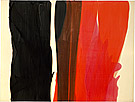Morris LOUIS
Morris Louis Bernstein was born on 28 November 1912 in Baltimore, Maryland, of Russian parents. He attended the Maryland Institute of Fine and Applied Arts, Baltimore, between 1927 and 1932. In 1934 he was employed by the Public Works of Art Project[1] to assist in the painting of a mural in the library of Hampstead Hill School. He moved to New York in 1936, where he attended the workshop of the Mexican artist David Siqueiros and experimented with a variety of techniques and materials. He contributed to an exhibition at the American Contemporary Art Gallery, New York, in 1937, using the name 'Morris Louis'. Between 1939 and 1940 Louis was employed on the Federal Art Project of the Works Progress Administration (WPA), and in 1939 exhibited work with the WPA painters at the World's Fair, New York. He returned to Baltimore for a few years in the mid 1940s before moving to Silver Spring, Maryland, a suburb of Washington DC. Louis supported himself by teaching part-time at the Washington Workshop Center of the Arts and by giving private classes.
In 1953 Louis and Kenneth Noland visited New York, where the critic Clement Greenberg took them to the studio of Helen Frankenthaler. Louis' first solo exhibition took place immediately afterwards, at the Washington Center Art Gallery, although he was already working in a new way inspired by his New York visit. These paintings were shown at the exhibition Emerging talent, held at the Kootz Gallery, New York. Louis continued to exhibit regularly, but in 1957 a reassessment led him to destroy most of the paintings he had made between 1955 and 1957. He began working on his series of Veils at this time. The first Veil was exhibited at The international art of a new era: USA, Japan, Europe, in Osaka and then Philadelphia. More works from the series were shown in his 1959 solo exhibition at French and Company, New York, which was organised by Greenberg. Louis rapidly moved to other series: the Florals, the Unfurleds and the Stripes. In 1960 he held solo exhibitions in New York, London, Milan and Rome. In 1961 he was included in the exhibition American Abstract Expressionists and imagists at the Solomon R. Guggenheim Museum, New York, and later in Greenberg’s exhibition of Post-Painterly Abstraction at the Los Angeles County Museum of Art in 1964. Louis died in Washington DC on 7 September 1962. A retrospective of his work was held at the Musée de Grenoble in 1996.
[1] During the Great Depression, the Federal Art Projects of the Works Progress Administration saw artists employed to create murals and other public works, as well as art instruction and art research.




